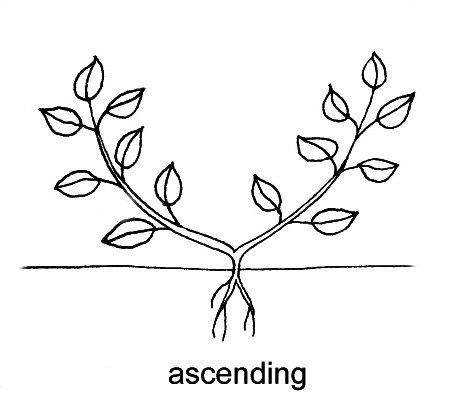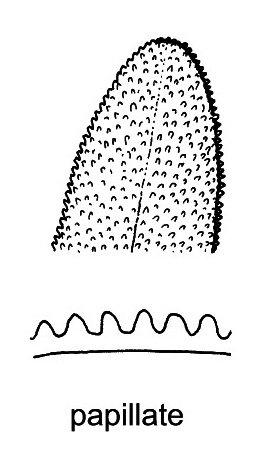|
|
 |
Key to StellariaView taxon page for Stellaria
(For a list of species in Stellaria, use the above link.) Jepson Manual glossary definitions can be seen by moving your cursor over words underlined with dots. 1. Annual, from slender to thread-like taproot 2. Leaves crowded near base, upper lance-linear (to ovate); internode  Segment of an axis (generally a stem) between successive positions (nodes) from which one or more structures (especially leaves, buds, branches, or flowers) arise. hairs 0 or scattered; bracts scarious ..... S. nitens 2' Leaves ± evenly spaced, ± ovate  Egg-shaped (i.e., widest below the middle) in two dimensions (i.e., in one plane), as a leaf. ; internode hairs in line; bracts leaf-like 3. Sepals 2–3 mm, < 4 mm in fruit; petals 0; seeds 0.7–0.8 mm, yellow- to light red-brown ..... S. pallida 3' Sepals 3–6 mm, > 6 mm in fruit; petals generally present; seeds 0.9–1.7 mm, dark red- or purple-brown to brown 1' Perennial herb, from slender rhizomes 5. Plant covered (except ± leaves) with long wavy hairs – coastal ± marshes, bluffs, NCo, CCo ..... S. littoralis 5' Plant glabrous or hairs restricted to stem or leaf  Organ arising from a stem, generally composed of a stalk (petiole) and a flat, expanded, green, photosynthetic area (blade); distinguished from a leaflet by the presence in its axil of a bud, branch, thorn, or flower; sometimes with lateral, basal appendages (stipules); either simple (toothed, lobed, or dissected but not divided into leaflets) or compound (divided into leaflets). margin 7. Inflorescence ± narrow; pedicels  Stalk of an individual flower in an inflorescence, or the corresponding structure in fruit. ascending  Curving or angling upward from base, or about 30-60 degrees less than vertical or away from axis of attachment. to erect  Upright; vertically oriented. ; flowers generally 1–7 ..... S. longipes subsp. longipes 7' Inflorescence open, branches widely spreading  Oriented more or less perpendicularly to the axis of attachment; often, more or less horizontal. ; pedicels spreading or reflexed  Abruptly bent or curved downward or backward. ; flowers generally many 8. Sepals 4–5.5 mm, margin densely ciliate  Having generally straight, conspicuous hairs along margins or edges. or not; inflorescence terminal; seeds with prominent, elongate tubercles; leaf margin ± not papillate  Pertaining to a surface (e.g., of a leaf, stigma, fruit) bearing small, rounded or conic protuberances (papillae). , shiny ..... S. graminea 8' Sepals 3–4 mm, margin ± glabrous; inflorescence lateral; seeds minutely roughened; leaf margin papillate, dull ..... S. longifolia 6' Petals < 0.8 × sepals or 0 9. Flowers few (alpine) to many, in umbel-like cyme  1. In flowering plants excluding Asteraceae and some other groups, a branched inflorescence in which the central or uppermost flower opens before the peripheral or lowermost flowers on any axis. see 2. In Asteraceae and some other groups, a cyme-like inflorescence is one in which the central or uppermost inflorescence units (e.g., heads in Asteraceae, umbels enclosed by involucres in Eriogonum), instead of individual flowers, develop and mature before the peripheral or lowermost inflorescence units on any axis. ; bracts scarious; pedicels in fruit spreading to reflexed; petals 0 ..... S. umbellata 9' Flowers 1 in axils or few to many in terminal cyme; bracts leaf-like; pedicels in fruit spreading to recurved  Gradually curved downward or backward. or reflexed; petals present or 0 10' Flowers generally few to many in terminal or axillary  Pertaining to or within an axil, especially a leaf axil. cymes  1. In flowering plants excluding Asteraceae and some other groups, a branched inflorescence in which the central or uppermost flower opens before the peripheral or lowermost flowers on any axis. see 2. In Asteraceae and some other groups, a cyme-like inflorescence is one in which the central or uppermost inflorescence units (e.g., heads in Asteraceae, umbels enclosed by involucres in Eriogonum), instead of individual flowers, develop and mature before the peripheral or lowermost inflorescence units on any axis. ; petals generally present; leaf lanceolate  Narrowly elongate, widest in the basal half, often tapered to an acute tip. to ovate 11. Leaf ± lanceolate to widely so, primary blades mostly > 2 cm, margin papillate, dull; internodes  Segment of an axis (generally a stem) between successive positions (nodes) from which one or more structures (especially leaves, buds, branches, or flowers) arise. generally finely papillate; sepals 3–3.5 mm, in fruit < 4.5 mm, with generally 3 ribs; styles generally 0.9–1.6 mm, slender, straight (often contorted on dried specimens) ..... S. borealis subsp. sitchana 11' Leaf elliptic  In the shape of a flattened circle or ellipse; wider than linear to ovate, primary blades mostly < 2 cm, margin ± not papillate, shiny; internodes not papillate; sepals 1.5–2.5 mm, in fruit < 3 mm, with generally 1–3 obscure veins; styles generally 0.5–0.9 mm, thick, outcurved ..... S. calycantha
Please use this Google Form for Contact/Feedback
Citation for the whole project: Jepson Flora Project (eds.) . Jepson eFlora, https://ucjeps.berkeley.edu/eflora/ [accessed on ]
Citation for an individual treatment: [Author of taxon treatment] [year]. [Taxon name] in Jepson Flora Project (eds.) Jepson eFlora, [URL for treatment]. Accessed on .
We encourage links to these pages, but the content may not be downloaded for reposting, repackaging, redistributing, or sale in any form, without written permission from The Jepson Herbarium.
|
|
 |

